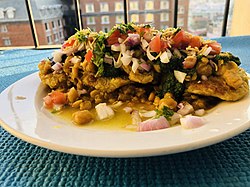This article needs additional citations for verification .(April 2021) |
 | |
| Place of origin | India |
|---|---|
| Region or state | Maharashtra, Gujarat |
| Main ingredients | yellow peas, potatoes, spices |
| Variations | Samosa ragda, chhole tikki |
Ragda patties (colloquially ragda pattice) is a dish of mashed potato patties and pea sauce, and is part of the street food culture in the Indian states of Gujarat and Maharashtra. [1] It is similar to chhole tikki, more popular in North India. This dish is a popular street food offering and is also served at restaurants that offer Indian fast food. Pattice may be a localization of the English word 'patties', and refers to the potato cakes at the heart of the dish. [2]

